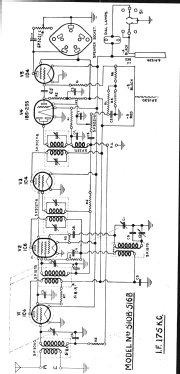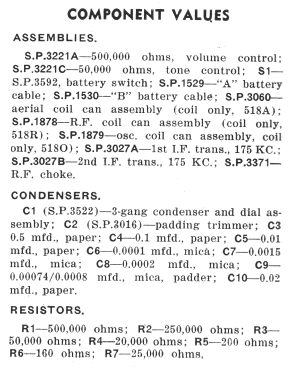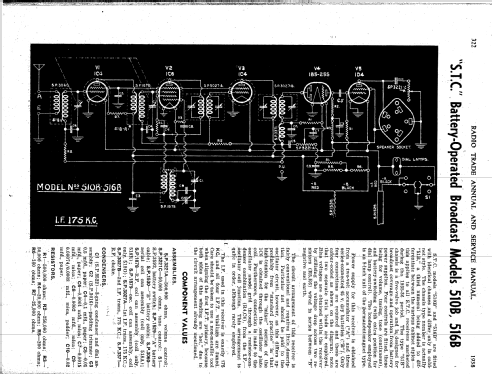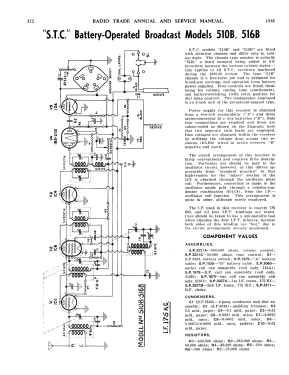- Country
- Australia
- Manufacturer / Brand
- Standard Telephones and Cables Pty, Ltd (STC), Sydney
- Year
- 1936
- Category
- Broadcast Receiver - or past WW2 Tuner
- Radiomuseum.org ID
- 169747
Click on the schematic thumbnail to request the schematic as a free document.
- Number of Tubes
- 5
- Main principle
- Superhet with RF-stage; ZF/IF 175 kHz; 2 AF stage(s)
- Tuned circuits
- 7 AM circuit(s)
- Wave bands
- Broadcast only (MW).
- Power type and voltage
- Storage and/or dry batteries / 135 & 2 Volt
- Loudspeaker
- Permanent Magnet Dynamic (PDyn) Loudspeaker (moving coil) / Ø 8 inch = 20.3 cm
- Material
- Wooden case
- from Radiomuseum.org
- Model: 510B Ch= 51B - Standard Telephones and Cables
- Shape
- Console, Lowboy (legs < 50 %).
- Notes
-
S.T.C. models "510B" and "516B" are fitted with identical chasses and differ only in cabinet style. The chassis type number is actually "51B," a third numeral being added to differentiate between the various cabinet styles this applies to all S.T.C. receivers marketed during the 1935-36 period. The type "51B” chassis is a five-valve job and is designed for broadcast coverage and operation from battery power supplies. Four controls are fitted, these being for volume, tuning, tone (continuous), and battery-switching (with an extra position for dial lamp control).
The loudspeaker employed is an 8-inch unit of the permanent magnet type.The power supply for this receiver is obtained from a two-volt accumulator ("A") and three series-connected 45 v. dry batteries ("B"). Only four connections are required and these are colour coded as shown on the diagram; note that two separate twin leads are employed.
Bias voltages are obtained within the receiver by utilising the voltage drop across two resistors (R5, R6) wired in series between "B" negative and earth.
The circuit arrangement of this receiver is fairly conventional and requires little description.
Particular notice should be paid to the oscillator circuit, however, as this differs appreciably from "standard practice" in that high tension for the "mixer" section of the 1C6 is obtained through the oscillator plate coil. Furthermore, the connection is made to the oscillator anode grid through a resistor-condenser combination (R4, C4), from the IF oscillator coil junction. This arrangement is quite in order, although rarely employed.
The IF used in this receiver is exactly 175 KC. and all four IFT windings are tuned.
Care should be taken to use a non-metallic tool when aligning the first IFT primary, because both sides of this winding are "hot," due to the circuit arrangement already mentioned.
Radio Trade Annual 1939, Page 322.
- Price in first year of sale
- 29.00 Aus£
- Literature/Schematics (1)
- Radio Trade Annual 1938 P322.
- Author
- Model page created by Stuart Irwin. See "Data change" for further contributors.
- Other Models
-
Here you find 614 models, 263 with images and 302 with schematics for wireless sets etc. In French: TSF for Télégraphie sans fil.
All listed radios etc. from Standard Telephones and Cables Pty, Ltd (STC), Sydney



